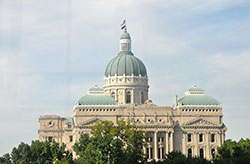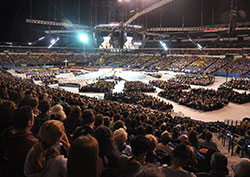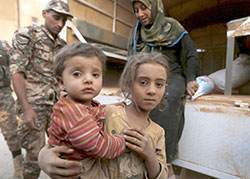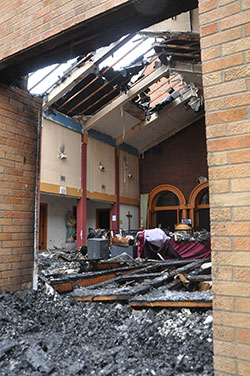Bishops’ pastoral letter on the poor tops local news stories
By Brandon A. Evans
 A pastoral letter from the bishops of Indiana which called the needs of the poor a priority was voted the top local news story of 2015—followed closely by religious freedom legislation in the state of Indiana, and our local pilgrims’ encounter with Pope Francis during his visit to the U.S.
A pastoral letter from the bishops of Indiana which called the needs of the poor a priority was voted the top local news story of 2015—followed closely by religious freedom legislation in the state of Indiana, and our local pilgrims’ encounter with Pope Francis during his visit to the U.S.
Other stories of note included the biannual National Catholic Youth Conference (NCYC), the opening of the Holy Year of Mercy, the resettling of a Syrian refugee family against the request of the governor and the elimination of annulment fees in the archdiocese.
Following the tradition of other news agencies, The Criterion editorial staff votes each year for the top 10 local stories that were published in our newspaper.
Many of the top 10 stories selected this year were covered in multiple articles. Read this article online at www.CriterionOnline.com to browse the links to all the original coverage.
Among the hundreds of locally produced news stories during 2015, here is our “Top 10” list:
1. In pastoral letter, Indiana bishops say needs of the poor must be a priority.
 The five Catholic bishops in Indiana have issued a pastoral letter on poverty inviting and challenging people in the state to make the needs of the poor a priority, and to take action to reduce the effects of poverty.
The five Catholic bishops in Indiana have issued a pastoral letter on poverty inviting and challenging people in the state to make the needs of the poor a priority, and to take action to reduce the effects of poverty.
The letter, titled “Poverty at the Crossroads: The Church’s Response to Poverty in Indiana,” was released in March and signed by Indianapolis Archbishop Joseph W. Tobin and the other four bishops of the state. It was also made available in Spanish.
A 2015 report by the Indiana Institute for Working Families showed that more than 1 million Indiana residents are living in poverty.
The bishops said it was their hope that Catholics throughout the state will read the pastoral letter, reflect on it and help the bishops consider how the Church should respond. The letter contained several questions for reflection, and included an online survey for the purposes of further addressing poverty in Indiana.
The bishops wrote: “We look forward to working with you to proclaim the Good News by strengthening family life, promoting just employment and ensuring a quality education and comprehensive health care for all Hoosiers, especially the poor and vulnerable.”
News Coverage:
Other Stories:
Archbishop Tobin's Columns:
Related:
2. Religious Freedom legislation becomes Indiana law; is revised amid controversy.
 During the final week of March, Indiana enacted a state-level version of the federal Religious Freedom Restoration Act (RFRA), with Gov. Mike Pence putting his stamp of approval on it on March 26. Nineteen other states had passed similar laws in the past.
During the final week of March, Indiana enacted a state-level version of the federal Religious Freedom Restoration Act (RFRA), with Gov. Mike Pence putting his stamp of approval on it on March 26. Nineteen other states had passed similar laws in the past.
“This bill is not about discrimination,” Pence said at the signing ceremony, “and if I thought it legalized discrimination in any way in Indiana, I would have vetoed it. For more than 20 years, the federal Religious Freedom Restoration Act has never undermined our nation’s anti-discrimination laws, and it will not in Indiana.”
Many people disagreed, and the bill became a national news story, with claims that the bill would actually allow for discrimination against people who identify as gay, lesbian, bisexual or transgender.
On April 2, a bill was passed intending to clarify RFRA’s intent. Glenn Tebbe, executive director of the Indiana Catholic Conference (ICC), said that the new language in the bill still raised some questions.
The bishops of Indiana also issued a statement, calling for “mutual respect” in discussion about the law so as “to ensure that no one in Indiana will face discrimination whether it is for their sexual orientation or for living their religious beliefs.”
News Coverage:
Other Stories:
Related:
3. Archdiocesan Catholics flock to the East Coast to pray with Pope Francis on his first journey to the U.S.
 When Pope Francis visited the U.S. in September, he was a busy man: he spoke to a joint session of Congress, canonized St. Junipero Serra in Washington, visited the Sept. 11 memorial in New York and participated in the World Meeting of Families (WMOF) in Philadelphia.
When Pope Francis visited the U.S. in September, he was a busy man: he spoke to a joint session of Congress, canonized St. Junipero Serra in Washington, visited the Sept. 11 memorial in New York and participated in the World Meeting of Families (WMOF) in Philadelphia.
Archdiocesan Catholics were there nearly every step of way. Various groups—including 46 people who travelled on a pilgrimage to the WMOF—made their way through traffic and crowds to see the pope.
Maria Pimentel-Gannon, a member of St. Monica Parish in Indianapolis, was in the audience when the Holy Father delivered an address to a joint session of Congress. “It was an unbelievable experience. My heart pounded, and I started to cry when he was introduced. He walked in ever so humbly, and the tears started to roll for me. That moment will be forever embedded in my mind.”
“That’s why we’re drawn to [Pope Francis] … ” said Father Eric Augenstein, archdiocesan vocations director. “Not to see a celebrity, but to glimpse the face of Jesus in the shepherd that he has given us here on Earth.”
“We’re able to remind everyone that it’s not just about the pope,” said Annie Harton, a young adult member of St. Pius X Parish in Indianapolis. “It’s about the Church, the Mass and the Eucharist. So we had a lot of fun trying to figure out how we can evangelize and remind people of what’s really important.”
News Coverage:
Other Stories:
Related:
4. 23,000 youths from around the country come to Indianapolis for the biannual National Catholic Youth Conference.
 The three-day event—now practically a staple in Indianapolis because of its central location and convention center—gives young people the chance to attend Mass, pray, go to confession, hear uplifting talks and meet other Catholics from all over the country.
The three-day event—now practically a staple in Indianapolis because of its central location and convention center—gives young people the chance to attend Mass, pray, go to confession, hear uplifting talks and meet other Catholics from all over the country.
Reporter Sean Gallagher spoke with Leanna Long, who hailed from a town in North Carolina where Catholics are a small minority.
She felt “amazingly overwhelmed” to be in the midst of so many people who shared her faith. “We know the Church is large, but to be able to see it and know that I’m not alone [is helpful].”
“In her words,” Gallagher reported, “Leanna captured the Church’s youthful vitality and diverse universality. Both were on display on Nov. 21 as conference attendees were led in worship on the feast of Christ the King by Cardinal Oscar Rodriguez Maradiaga of Tegucigalpa, Honduras.”
Archbishop Tobin also celebrated a special opening Mass for more than 1,000 archdiocesan youths, telling them, “If today you hear his voice, harden not your heart” (Ps 95:7-8).
News Coverage:
Other Stories:
Related:
5. Archdiocese prepares for and opens the Extraordinary Jubilee of Mercy.
 In April of this year, on the Feast of Divine Mercy, Pope Francis declared an Extraordinary Jubilee Year dedicated to mercy to begin on Dec. 8, 2015, and end on Nov. 20, 2016. Its theme is “Merciful Like the Father.”
In April of this year, on the Feast of Divine Mercy, Pope Francis declared an Extraordinary Jubilee Year dedicated to mercy to begin on Dec. 8, 2015, and end on Nov. 20, 2016. Its theme is “Merciful Like the Father.”
In response, the archdiocese has planned events for the jubilee, offered resources on its website and opened two holy doors: one at SS. Peter and Paul Cathedral in Indianapolis and the other at the Archabbey Church of Our Lady of Einsiedeln in St. Meinrad.
Catholics in central and southern Indiana are urged to not only enjoy the spiritual benefits of this year, particularly through the sacrament of penance, but also reach out in God’s mercy to those around them who need it.
“The Holy Father has indicated that for us to be able to show mercy like the Father, we must encounter it for ourselves,” said Father Patrick Beidelman, executive director of the archdiocesan Secretariat for Spiritual Life and Worship.
News Coverage:
Other Stories:
Related:
6. Amid controversy, archdiocese resettles Syrian refugee family.
 A family of four refugees, having survived not only war-torn Syria but also three years of waiting, was finally brought to the U.S. to be resettled by Catholic Charities Indianapolis’ Refugee and Immigrant Services on Dec. 7.
A family of four refugees, having survived not only war-torn Syria but also three years of waiting, was finally brought to the U.S. to be resettled by Catholic Charities Indianapolis’ Refugee and Immigrant Services on Dec. 7.
The move was not without controversy, as the resettlement happened against the wishes of Governor Pence—though with permission of the U.S. federal government.
Reporter Natalie Hoefer noted, “On Dec. 2, Archbishop Joseph W. Tobin met with the governor to discuss the family’s plight, to reassure him that they had gone through an extensive background check, and to explain the archdiocese’s refugee resettlement process.”
In a public statement announcing the archdiocese had carried out its plan to resettle the family in Indiana, Archbishop Tobin said, “For 40 years, the Archdiocese’s Refugee and Immigrant Services has welcomed people fleeing violence in various regions of the world. This is an essential part of our identity as Catholic Christians, and we will continue this life-saving tradition.”
Though he respectfully disagreed with the decision, Governor Pence said he would not withhold state benefits from the Syrian family.
News Coverage:
Other Stories:
Related:
7. Archbishop Tobin announces the elimination of annulment fees.
 Citing misconceptions about people being able to “buy” a decree of nullity of a marriage, this summer Archbishop Tobin noted that the $675 fee for processing annulment cases was being permanently waved.
Citing misconceptions about people being able to “buy” a decree of nullity of a marriage, this summer Archbishop Tobin noted that the $675 fee for processing annulment cases was being permanently waved.
“Effective on July 1, 2015, all fees connected with the processing of petitions for the nullity of marriages have been eliminated,” he said. “In the case of persons who have already introduced a petition, the balance of their fees are now forgiven.”
He said that “my heart goes out to the many good people who have suffered the tragic breakup of their marriage.
“My hope is that the decision to waive the fees for the annulment process may encourage these brothers and sisters who have a doubt regarding the sacramentality of their previous marriage to submit a petition to our Metropolitan Tribunal.”
News Coverage:
Related:
8. St. Monica parishioners turn to God after a fire destroys the narthex of the Indianapolis church.
 On the morning of Sept. 9, an accidental fire at St. Monica Parish in Indianapolis destroyed its narthex. The sanctuary, parish offices and surrounding areas also sustained extensive water and smoke damage.
On the morning of Sept. 9, an accidental fire at St. Monica Parish in Indianapolis destroyed its narthex. The sanctuary, parish offices and surrounding areas also sustained extensive water and smoke damage.
No one was injured in the blaze, and the school was not damaged, though classes were cancelled the rest of the week.
Still, only four hours after the fire started, Mass was celebrated in the gym.
“A building, while it may have sentimental value, at the end of the day is still just a building,” said Father Todd Goodson, pastor of St. Monica Parish, during a homily. “And we, united by the Eucharist, are the Church. We are the body of Christ sent out into the world. … We will go on proclaiming the Gospel. Us gathering around the Eucharist and praying together is, in fact, what makes us the Church.”
No specific timetable for reuse of the church or reconstruction of the narthex has been set.
News Coverage:
Related:
9. Three men are ordained priests for the archdiocese.
 Nearly 800 friends and family members—and 80 priests—filled SS. Peter and Paul Cathedral in Indianapolis on June 6 for the ordination of Fathers Adam Ahern, Michael Keucher and Andrew Syberg.
Nearly 800 friends and family members—and 80 priests—filled SS. Peter and Paul Cathedral in Indianapolis on June 6 for the ordination of Fathers Adam Ahern, Michael Keucher and Andrew Syberg.
During the homily, Archbishop Tobin sat before the three men and addressed them directly.
“It seems to me that three considerations are especially important in understanding the office which our brothers are to assume today,” he said. “The ordained ministry should be an exercise in a personal, collegial and communal way.”
Reporter Natalie Hoefer wrote, “Archbishop Tobin’s words were followed by a series of symbolic rituals the three men participated in as part of the sacrament of holy orders: prostration before the altar during the Litany of the Saints; laying-on of hands; donning of priestly vestments; anointing of their hands with chrism oil; presentation of the chalice and paten; and the welcoming embrace by the archbishop and each of the priests in attendance.”
News Coverage:
Other Stories:
Related:
10. The local Church reacts to the same-sex marriage ruling of the U.S. Supreme Court.
 In a landmark ruling issued on June 26, the U.S. Supreme Court expanded the civil definition of marriage to include couples of the same sex.
In a landmark ruling issued on June 26, the U.S. Supreme Court expanded the civil definition of marriage to include couples of the same sex.
Archbishop Tobin responded: “This decision does not change the truth that is older than states and courts. The Catholic Church, along with other faith traditions, teaches that marriage is a natural institution established by God to be a permanent union between one man and one woman, intended towards the formation of a family in which children are born and nurtured.”
The ruling coincided with a planned rally for religious freedom (part of the U.S. Bishops’ “Fortnight for Freedom”). Father Bryan Eyman, pastor of St. Athanasius the Great Byzantine Catholic Parish in Indianapolis, spoke at the June 27 rally.
“Pray that each and every one of us here is able to have the strength and power of the Holy Spirit to stand up for religious freedom, and to boldly and publicly live our faith, regardless of what the Supreme Court, the president, Congress or any level of government tells us.”
(To read the original coverage, including additional links of interest, click on the headline for this story on our website at www.CriterionOnline.com.) †
News Coverage:
Other Stories:
Related:






 A family of four refugees, having survived not only war-torn Syria but also three years of waiting, was finally brought to the U.S. to be resettled by Catholic Charities Indianapolis’ Refugee and Immigrant Services on Dec. 7.
A family of four refugees, having survived not only war-torn Syria but also three years of waiting, was finally brought to the U.S. to be resettled by Catholic Charities Indianapolis’ Refugee and Immigrant Services on Dec. 7. Citing misconceptions about people being able to “buy” a decree of nullity of a marriage, this summer Archbishop Tobin noted that the $675 fee for processing annulment cases was being permanently waved.
Citing misconceptions about people being able to “buy” a decree of nullity of a marriage, this summer Archbishop Tobin noted that the $675 fee for processing annulment cases was being permanently waved.

